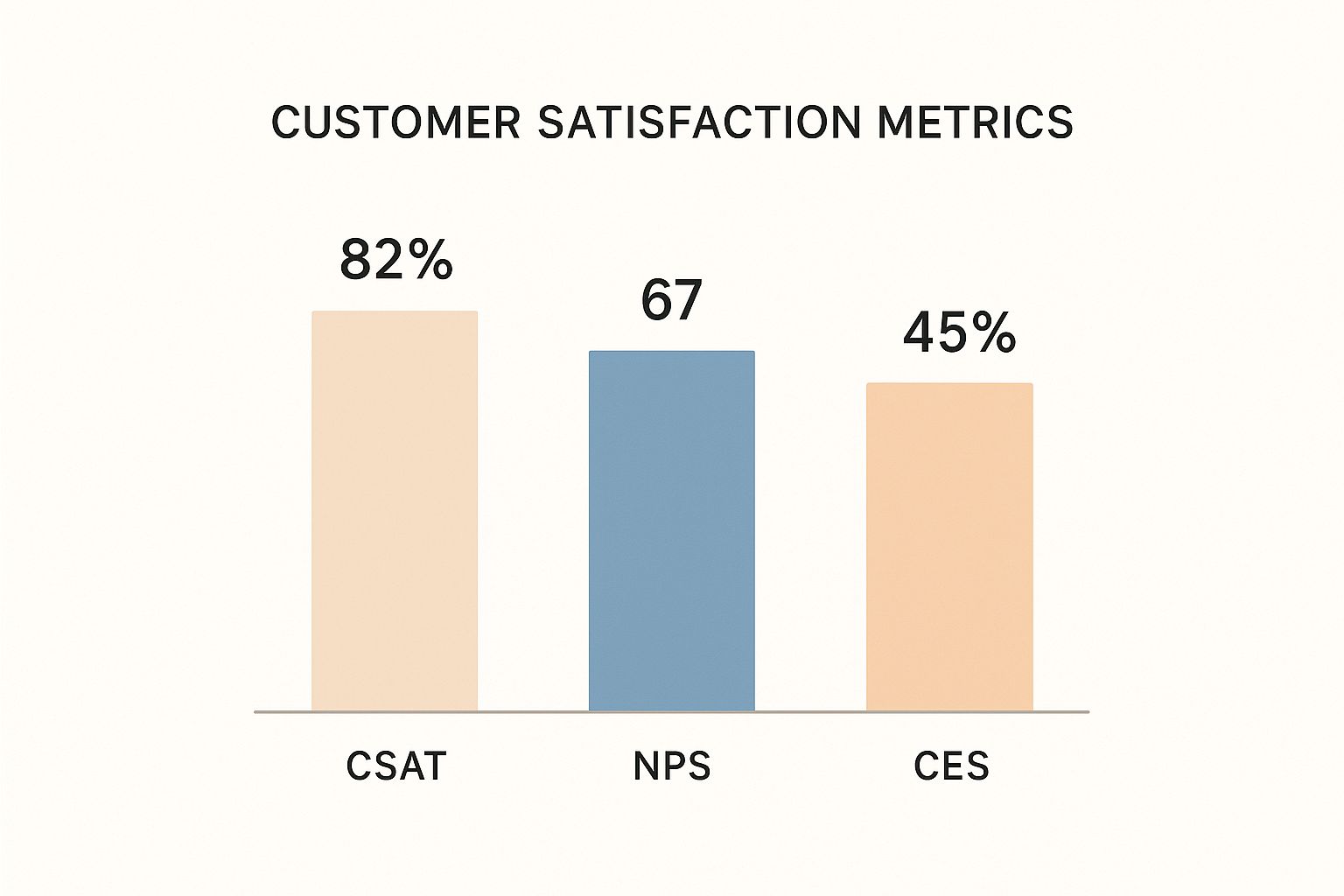A Friendly Guide to Customer Satisfaction Measurement
Ever feel like you’re just guessing what your customers think about your products? Yikes. We’ve all been there. The real secret to sustainable growth isn't some complex marketing algorithm; it's getting inside your customers' heads and understanding how they truly feel.
This is where customer satisfaction measurement becomes your most powerful tool. It’s not about chasing a perfect score for a report card. It’s about building a practical roadmap for a better business, one piece of feedback at a time.
This guide is here to cut through the noise and demystify the entire process. We're going to break down the essentials in plain English, showing you exactly how to turn customer feedback into tangible business results. Ready to stop guessing and start growing? Let's dive in.
Why Measuring Customer Happiness Is Your Ultimate Growth Hack
Think of measuring customer satisfaction as having a direct conversation with your customers, one that helps you see your business through their eyes. When you start systematically listening, you stop making assumptions and start making smart, data-driven decisions that build incredible loyalty and drive real growth.

We get it-the whole idea of surveys, metrics, and data can sound a little intimidating. But what if we told you it’s much simpler than you think? For us at Yuve, customer feedback is everything. It’s how we find out if a new vegan protein flavor is a hit or if the new packaging for our vitamins is a hassle to open. Every single comment helps us get better.
What This Guide Will Do for You
This guide will show you how to turn customer feedback into your business’s superpower.
Here’s a quick look at what you’ll discover:
- The "Big Three" Metrics: We’ll walk through the must-know scores that give you a clear, at-a-glance picture of customer happiness.
- Simple Tools to Get Started: You don’t need a massive budget or a data science degree to start gathering incredibly valuable feedback.
- Turning Insight into Action: Learn how to translate raw scores and comments into real-world improvements your customers will notice and love.
The goal isn’t just to collect data; it’s to build relationships. When customers feel heard, they become more than just buyers-they become your most passionate advocates. In fact, a HubSpot survey found that 80% of customers would stop doing business with a company because of a poor experience. That’s a powerful reason to start listening.
By the end of this guide, you’ll have a clear, actionable plan to turn customer opinions from simple data points into your most valuable asset for growth. To get a head start, you can also explore these top customer satisfaction measurement methods which cover key approaches like NPS and CSAT.
Let’s get started.
The Three Essential Customer Feedback Metrics
Trying to get a handle on customer satisfaction can feel like wading into a sea of acronyms. NPS, CSAT, CES-it’s enough to make your head spin. But trust us, it’s much simpler than it looks. Think of these as your core toolkit for understanding what customers really think and feel about your brand. Each one asks a slightly different question, giving you a unique piece of the puzzle. Let's break them down.
NPS: The Loyalty Check
First up is the big one: the Net Promoter Score (NPS). This is your go-to metric for measuring long-term customer loyalty and overall brand health. It’s the "big picture" score.
NPS boils down to a single, powerful question:
"On a scale of 0-10, how likely are you to recommend [our brand/product] to a friend or colleague?"
Based on their answer, you can group your customers into three distinct camps:
- Promoters (9-10): These are your champions. They love what you offer and are actively spreading the word.
- Passives (7-8): They’re satisfied enough for now, but not truly enthusiastic. They could easily be tempted by a competitor's offer.
- Detractors (0-6): Dun, dun, dun-unhappy customers. They might share negative feedback, potentially damaging your brand's reputation.
Essentially, NPS answers the question, "Are we creating genuine brand advocates?" For a business like Yuve, a quarterly NPS survey is an incredible way to track how our commitment to quality ingredients resonates with customers over time. Introduced in 2003, research shows companies with the highest NPS scores tend to grow more than twice as fast as their competitors.
CSAT: The Instant Reaction
Next, we have the Customer Satisfaction Score (CSAT). If NPS is about the long-term relationship, think of CSAT as the immediate "How did we do just now?" snapshot.
This metric is designed to measure satisfaction with a specific, recent interaction. The question is usually something like:
"How satisfied were you with your recent [purchase/support chat/delivery]?"
Customers typically respond on a 5-point scale, from "Very Unsatisfied" to "Very Satisfied." Your CSAT score is simply the percentage of customers who chose "Satisfied" or "Very Satisfied." It’s direct, simple, and gives you real-time feedback on your day-to-day operations. Imagine someone just bought your vegan collagen. A day after it arrives, they get a quick email asking them to rate the purchase experience. That's a CSAT survey in action-timely, focused, and incredibly useful.
CES: The Ease-of-Use Score
Finally, there’s the Customer Effort Score (CES). This one is all about a single, crucial idea: how easy was it for your customer to get what they needed?
The question it asks is refreshingly straightforward:
"How easy was it to get your issue resolved today?"
Customers respond on a scale from "Very Difficult" to "Very Easy." The insight here is profound: customers are more loyal to brands that make their lives easier. A low-effort experience-like finding a product in seconds or getting a quick answer from support-builds lasting loyalty. A high-effort one, filled with frustrating roadblocks and long wait times, is a sure way to drive customers away.
Here’s a quick visual comparison of these key metrics, based on some sample data.

This chart is a great example of how the metrics work together. It shows that while overall satisfaction (CSAT) is high, the effort required from customers (CES) might be a pain point worth investigating.
Comparing Key Customer Satisfaction Metrics
To make it even clearer, here’s a quick-glance comparison of the three essential customer satisfaction metrics. This should help you decide which one best fits your immediate goals.
| Metric | What It Measures | Typical Question | When to Use It |
|---|---|---|---|
| NPS | Overall brand loyalty and the likelihood of customer referrals. | "How likely are you to recommend us to a friend?" | To gauge long-term brand health and predict growth. Great for quarterly or annual check-ins. |
| CSAT | Immediate satisfaction with a specific product, service, or interaction. | "How satisfied were you with your recent purchase?" | Right after key moments in the customer journey, like a purchase or a support ticket resolution. |
| CES | The ease of a customer's experience when trying to get something done. | "How easy was it to handle your request?" | After interactions where effort matters, like using your website's checkout or contacting support. |
By using these three metrics together, you stop guessing and start truly understanding your customers. You can see your overall brand loyalty (NPS), pinpoint satisfaction at key moments (CSAT), and find and fix friction points in your customer journey (CES). This trio gives you a powerful, multi-dimensional view of your customer experience. For a deeper dive into how to apply these, you can explore more insights on customer satisfaction methods.
How to Choose the Right Feedback Tools
Alright, you know what you need to measure. Now comes the practical part: how do you actually gather that feedback? Picking the right tools can feel like a huge task, but it’s simpler than you think. The real goal is to find a system that encourages honest feedback without creating a ton of extra work for you and your team.
Think of it like outfitting your kitchen. Sometimes, a simple hand mixer (a free tool) is perfect for the job. Other times, you need a powerful stand mixer (a more advanced platform) to handle a much bigger, more complex recipe. It all comes down to what you’re trying to achieve. Let’s break down the options.

Starting Simple: Free and Low-Cost Options
When you're first getting started, you don't need a massive, expensive system. You just need to open a line of communication with your customers. The good news is, there are some fantastic free tools that can get you up and running in no time.
- Google Forms: This is the classic starting point for a reason. It’s 100% free, incredibly intuitive, and flexible enough to create simple CSAT, NPS, or CES surveys. You can just drop the link in a post-purchase email or on your order confirmation page. Easy.
- SurveyMonkey (Basic Plan): The free version of SurveyMonkey is a great step up. It offers more polished templates and some basic analytics, giving your surveys a more professional look without the price tag.
These tools are ideal for getting that first wave of feedback and spotting any major trends. They help you build the crucial habit of listening to your customers before you make a bigger financial commitment.
Scaling Up: Platforms for Growing Businesses
As your business grows, your needs will evolve. Sending surveys manually and trying to make sense of spreadsheet responses just won't cut it anymore-it becomes a massive time sink. This is the point where investing in a dedicated customer feedback platform can be a game-changer.
These platforms automate the whole feedback loop, from sending a survey at the perfect moment to analyzing the responses for you. They transform raw data into clear, actionable insights. Imagine a platform flagging a sudden drop in CSAT scores tied to a new shipping partner-it would allow you to investigate and fix the problem before it spirals.
It's a fact: 96% of consumers say customer service is a major factor in their loyalty to a brand, according to HubSpot. The right tool is what empowers you to deliver that service consistently.
Must-Have Features in a Feedback Tool
When you’re ready to invest, don't get sidetracked by flashy features you’ll probably never use. Focus on the core functions that will genuinely help you understand and improve the customer experience.
Here’s a practical checklist of what really matters:
- Multi-Channel Delivery: Your customers are everywhere, and your surveys should be too. Look for a tool that can send feedback requests via email, SMS, and even on-site pop-ups.
- Smart Automation: The platform must let you set up triggers. For instance, it should be able to automatically send a CSAT survey 24 hours after a product is delivered or an NPS survey 30 days after a customer’s first purchase.
- Clear Dashboards: You need to see trends at a glance, not dig through endless data. A good tool gives you clean, visual dashboards that track your NPS, CSAT, and CES scores over time, so you can spot improvements or problems right away.
- CRM Integration: This is non-negotiable. Your feedback tool absolutely has to connect with your Customer Relationship Management (CRM) software. This ties feedback directly to individual customer profiles, giving you a 360-degree view of their entire journey with your brand.
Choosing the right tool is ultimately about finding a partner that helps you listen better and act faster. Start simple, and as you grow, find a platform that can grow with you. Let customer feedback become your most trusted guide for making smarter business decisions.
Turning Customer Feedback into Real Action
So, you’ve gathered all this feedback. Great. But collecting scores and comments is just the starting line. The real work-the part that actually grows your business-is turning that raw data into changes your customers can see and feel.
This isn't about creating another report to sit in a folder. It's about building a roadmap for improvement, one that's drawn directly by your customers. Let's break down how to connect the dots and make changes that actually move the needle.
From Data Points to Clear Patterns
Your feedback will essentially come in two forms: the numbers (quantitative) and the stories (qualitative). You absolutely need both to understand what’s going on.
Think of it like this: your CSAT or NPS score is the "what." It tells you what your customers are feeling. The open-ended comments they leave behind are the "why." They tell you why they feel that way.
Start by spotting trends in the hard data. Did your satisfaction score take a nosedive right after you switched shipping carriers? That’s your first clue. Now, dig into the comments and support tickets from that same period. Are people complaining about delivery times or damaged boxes?
When you see a dozen different customers praising your vegan protein but all mentioning the new packaging is a nightmare to reseal, you’ve struck gold. That’s not a one-off gripe; it’s a pattern demanding attention.
How to Prioritize Your Action Plan
You can’t fix everything at once. If you try, you’ll end up doing nothing well. The secret is to prioritize the changes that will give you the biggest bang for your buck-the ones that will positively impact the most customers.
Here’s a simple but effective way to sort through the noise:
- High Impact, Low Effort: These are your quick wins. A customer points out a confusing typo on the checkout page? Fix it. That’s a small change that improves the experience for everyone who follows. Tackle these immediately.
- High Impact, High Effort: Think bigger projects, like a complete packaging redesign based on that feedback about the resealable pouch. These take planning and resources, but they're the game-changers.
- Low Impact, Low Effort: These are the small, "nice-to-have" tweaks. They won't revolutionize the customer experience, but you can slot them in when you have a spare moment.
- Low Impact, High Effort: Ideas that require a ton of work but only benefit a tiny sliver of your customer base? Push these to the very bottom of the list. Don't let them distract you.
This framework keeps you focused on what truly matters instead of getting lost in an endless to-do list.
Closing the Loop with Your Customers
This is arguably the most crucial step, and it’s shocking how many companies skip it. Closing the loop is simply the act of telling your customers you heard them and showing them what you did about it.
It doesn’t have to be complicated. A line in your next email newsletter that says, “You asked, we listened! Our protein powder now comes in an easy-to-reseal pouch” is all it takes.
This single action accomplishes two powerful things:
- It makes your customers feel seen and genuinely valued.
- It encourages them to keep giving you feedback because they know you’re actually listening.
You’re transforming a simple transaction into a real relationship. By joining our community, you can get the inside scoop on these changes as they happen. We often share updates and get ideas straight from the members of the Yuve Wellness Club.
Sadly, many companies stumble right here, at the gap between listening and acting. According to Forrester, only 13% of CX leaders believe their companies have the right tools to act on real-time feedback. What this means for you: actually taking action gives you a huge advantage. As you can see from these customer satisfaction findings, acting on feedback isn't just good service-it's smart business.
Building a Customer-First Company Culture

Customer satisfaction isn't a task you can delegate to a single department. It’s a mission that needs to be embraced by everyone. The best brands don't just pay lip service to their customers; they weave the customer's voice into the very fabric of their company, making it the heartbeat of every decision.
Just imagine what happens when your product developers, marketers, and even your finance team truly understand what makes a customer tick. The entire organization lines up behind one powerful goal: creating an experience people can't stop talking about. This is how you shift from simply tracking metrics to actively building a business that customers genuinely love.
Make Customer Feedback Everyone's Business
The first step is to bust customer feedback out of its silo. Survey scores and glowing testimonials shouldn't be hidden away in a dashboard only a few people ever see. That information needs to be front and center-shared, celebrated, and openly discussed across every team.
Here are a few simple ways to get the whole company in on the conversation:
- Kick off meetings with a customer story. Start your all-hands meetings by sharing a recent customer win or an insightful piece of feedback. It’s a powerful reminder of why you all do what you do.
- Create a dedicated Slack or Teams channel. Funnel positive reviews and constructive feedback into a public channel. This gives everyone a real-time pulse on how customers are feeling.
- Link goals to satisfaction metrics. When you tie team or even company-wide goals to key scores like NPS or CSAT, everyone has skin in the game. Suddenly, customer happiness becomes a shared responsibility.
The Yuve Origin Story: A Lesson in Listening
This philosophy is baked into our DNA. When our founder, Sam, started his own wellness journey, he grew frustrated with the supplements on the market. Too many caused digestive issues or were packed with ingredients he simply did not trust. He had a strong feeling he wasn't the only one.
He didn't just spot a gap in the market; he saw a whole community of people whose needs weren't being met. He took that frustration and used it as the blueprint for Yuve. Every single product was designed to be gentle, effective, and made with clean, plant-based ingredients, directly solving the pain points he and so many others felt. You can read more about the full Yuve story and the values that still guide us today.
This is the power of a customer-first culture in action. It’s not about reacting to complaints. It’s about proactively building what people truly need based on a deep, empathetic understanding of their struggles.
Empower Your Team to Be Problem-Solvers
A truly customer-centric culture gives every single employee the power to solve problems on the spot. It means trusting your team to make the right call for the customer, without getting them tangled up in bureaucratic red tape.
When an employee can confidently say, "I can fix that for you," it transforms a potentially negative moment into one that builds incredible loyalty. Fostering this environment starts with understanding the critical role of customer loyalty and recognizing how these small, positive interactions create a brand people stick with.
When your entire team is aligned around customer happiness, you build a business that doesn't just survive-it thrives.
Wrestling with Common Customer Feedback Challenges
Starting a customer satisfaction program rarely goes off without a hitch. We've been there, and it's okay to hit a few bumps in the road. Think of this section as your friendly field guide for navigating the most common issues that pop up.
We'll dig into the real-world headaches, from the deafening silence of low survey response rates to the sting of a negative review, and give you practical, no-fluff solutions to keep your feedback loop healthy and effective.
Overcoming Low Survey Response Rates
One of the first hurdles you'll likely face is just getting enough people to actually fill out your surveys. You craft the perfect questions, hit send, and then... crickets. It's a common frustration, but definitely one you can solve.
The problem usually isn't that customers are unwilling to share their opinions. More often, your request simply gets buried in a crowded inbox or feels like another tedious task. The trick is to make your survey invitation impossible to ignore and incredibly easy to complete.
Here are a few things that work wonders:
- Write a magnetic subject line: Ditch the boring "Share your feedback." Try something more engaging, like, "Quick question about your recent Yuve order?"
- Keep it short and sweet: Be upfront about the time commitment. Explicitly stating the survey will only take 2-3 minutes shows you respect their time, which is a powerful motivator.
- Optimize your timing: Don't wait. Send your survey when the experience is still fresh in your customer's mind. For a post-purchase CSAT survey, sending it about 24 hours after the product is delivered is often the sweet spot.
The Danger of "Satisfied but Not Loyal" Customers
Now, let's talk about a silent killer for many brands: the customer who claims to be satisfied but feels zero loyalty to you. They might give you a passing grade on a survey, but they'd jump ship the second a competitor offers a 10% discount. Relying on a single satisfaction metric can completely blind you to this risk.
A recent global study really brought this to light. It found that while overall customer satisfaction scores have held steady, the metrics that actually predict loyalty-things like trust, advocacy, and intent to buy again-are on the decline. This gap is a huge red flag. It means your "satisfied" customer might not be coming back. This is precisely why you need a multi-faceted measurement strategy; it helps you see past the surface and understand what truly keeps a customer with you for the long haul.
Turning Negative Feedback into a Positive Outcome
Let's be real: negative feedback stings. It can feel like a direct hit after all the effort you've put in. But what if you changed your perspective? What if you saw negative comments not as a failure, but as a free, high-value consulting report?
Your most vocal critics are often pointing directly at your biggest opportunities for growth. When a complaint comes in, your first instinct might be to get defensive. Fight that urge. Instead, view it as a gift. Thank the customer for taking the time to be honest, and if you can, follow up personally to show them what you're doing to fix the problem. That one simple act can transform a frustrated customer into your biggest fan. It proves you're not just collecting data-you're listening.
Your Customer Satisfaction Questions Answered
Jumping into customer satisfaction can feel like you're learning a new language. We get it! It’s a new muscle to flex for any business. Let's walk through some of the most common questions we hear from brands just getting started.
How Often Should I Survey My Customers?
This is a fantastic question, and the true answer is, it really depends on what you’re trying to learn. Think of it like your personal finances: you might glance at your checking account daily, but you probably only review your long-term retirement investments a few times a year. The same idea applies here.
- For quick feedback (CSAT/CES): These are best sent almost immediately after a customer interacts with you. Think within 24 hours of a product delivery or a chat with your support team. You want to catch them while the experience is still fresh.
- For big-picture loyalty (NPS): This is your long-term health check-up. Sending an NPS survey quarterly or even every six months is a great rhythm. It’s frequent enough to spot meaningful trends but not so often that you annoy your customers.
What Is The Best Way To Handle Negative Feedback?
First thing’s first: take a deep breath. Negative feedback isn’t a personal attack-it’s a gift. It comes from a customer who cares enough to tell you what’s wrong instead of just quietly taking their business elsewhere.
The key is to respond quickly, publicly (if the comment was public), and with genuine empathy.
Step 1: Acknowledge and Thank. Start by saying something like, "Thank you so much for bringing this to our attention. We're really sorry to hear your experience wasn't what it should have been."
Step 2: Take It Offline. Offer to fix their specific issue in a private channel. "We want to make this right. Could you please send us a direct message or an email with your order number?"
Step 3: Actually Fix It. This is the most important part. Follow through on your promise, and then dig deeper to fix the root cause so it doesn't happen again.
What’s The Simplest First Step for a Small Business?
Don't feel like you have to do everything at once. Just start with one simple, high-impact survey. For most brands, the easiest and most valuable place to begin is right after a purchase.
Set up a simple one-question CSAT survey using a free tool and pop the link into your order confirmation email. Ask something direct like, "How satisfied were you with your checkout experience today?" It's a low-effort way to start collecting powerful data right away.
For more answers to common questions, feel free to check out our full Yuve FAQ page.
At Yuve, we built our brand by listening. Ready to build a stronger connection with your own customers? A great first step is joining the Yuve Wellness Club to get exclusive insights and become part of our feedback community.
